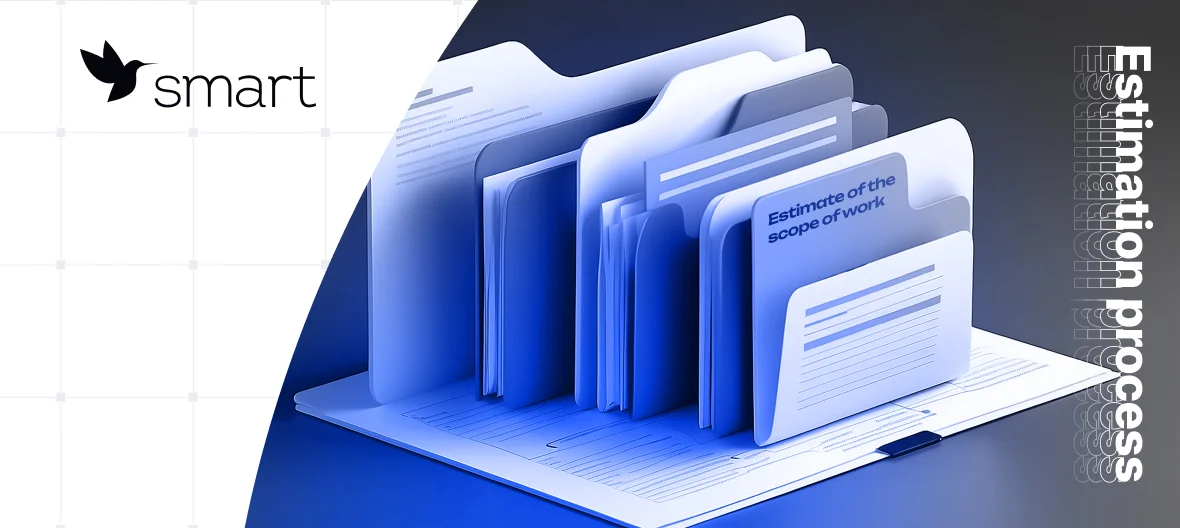The ERP implementation project estimation process is performed to determine the following key attributes:
- Scope,
- Work,
- Duration,
- Release plan,
- Cost,
- Licensing part of the project,
- Team,
- Assumptions & Constraints.
The estimation process diagram, composition, and final results of the operations within this process are given below:

The Project Estimation process activities are conducted in close cooperation between the Customer and the Contractor and can be described as follows:
- Define High-Level Scope – define the requirements for the ERP system functions based on a formal or informal request from the Customer. This task can be performed iteratively and usually requires formalization and classification of requirements. The standard Business Process Classifier is used for this purpose.
- Refine Requirements – clarify the Customer’s requirements by holding meetings, possibly demonstrating some of the ERP system’s functions, to understand the key issues/constraints/processes/expectations and other attributes that define the key project management factors (see above). This operation is used for low-complexity projects.
- Accomplish Discovery Project – this operation is essentially a subproject that is highly recommended to obtain a high-quality plan for the main implementation project. This subproject does not replace the Analysis phase within the main project (see the “D365FO ERP Implementation Methodology Matters” article) but allows for a sufficiently accurate development of an estimation and planning of the main ERP implementation project of medium and high complexity. The implementation of work within Discovery usually takes from 3 to 6 weeks and is paid, and funding from. Microsoft is also possible. The key deliverables of the Discovery subproject are as follows:
- Project Scope – processes/subprocesses, system modules,
- Release Plan – grouping of the Content for the purposes of incremental launch of these processes into operation:
- By processes,
- By legal entities,
- By geographical locations.
- Work for each Release with breakdown to the subprocess level,
- Duration,
- Cost,
- Project Team,
- System Landscape – a diagram of the interaction of ERP system modules and systems that make up the overall architecture of the future solution, including data flows and integration methods,
- Fit&Gap – percentage of coverage of the Customer’s requirements by the standard functionality of the system,
- Key project risks and their management methods,
- Key project estimation assumptions,
- Project constraints.
- Estimate Project – estimate the labor costs, qualitative and quantitative composition of the team, project duration with a breakdown by processes and project stages in the form of an estimate file.
- Negotiate Estimation – hold meetings to present, discuss and clarify the estimate data to ensure that all requirements, constraints, and expectations are taken into account and the estimate is understandable to the Customer.
- Create/Negotiate Commercial Proposal – develop a document summarizing the results of previous work, possibly a proposed ERP Implementation Project Plan in MS Project format, and also containing information regarding the cost of the Project and the System, as well as the elements this cost consists of and the principles of its formation. This document is a formal proposal and, if accepted by the Customer, is the basis for the preparation, approval and signing of the relevant Agreements.
Project cost of ERP implementation
Cost is one of the most important factors taken into account when choosing a particular ERP system and during its implementation. There are several aspects that should be understood and considered when estimating the cost of a particular project for the implementation of ERP Microsoft Dynamics 365 Finance and Operations Applications (Microsoft Dynamics 365 Finance, Microsoft Dynamics 365 Supply Chain Management, Microsoft Dynamics 365 Commerce and Microsoft Dynamics 365 Human Resources).
The TCO (Total Cost of Ownership) is determined for the entire life cycle of the system use and consists of the following elements:
- The cost of licenses for the Microsoft Dynamics 365 Finance and Operations Applications software product itself,
- The cost of environments that are necessary for the deployment and operation of the software product, if they are additional to those supplied as part of the ERP product,
- The cost of additional software products (e.g., Office 365, external Power BI, etc.), if their use is expected within the framework of the designed business processes, as well as additional modules and services (e.g., localization packages for some countries),
- The cost of the ERP system implementation project within the framework of those processes and their functions that are within the framework of the implementation project,
- The cost of post-project support for the system.
There are two possible options for constructing the ERP system implementation process itself:
- A comprehensive project (within one release or several releases), for which it is possible to plan the Scope before the start of the project,
- A release-by-release project, where the scope of work is planned before the start of each subsequent release (subprojects).
Accordingly, all the above cost elements are usually calculated (with the possible level of accuracy) before the start of the project or subproject, depending on the type of ERP system deployment, and are the baseline cost plan during the implementation project, along with the baseline plan for the scope of work (for more details, see “D365FO ERP Implementation Methodology Matters”).
- Cost of licenses for the Microsoft Dynamics 365 Finance and Operations Applications software product:
- The ecosystem distinguishes 4 main software products that can be purchased independently + additional software packages that provide a number of specific functions: Microsoft Dynamics 365 Finance, Microsoft Dynamics 365 Supply Chain Management, Microsoft Dynamics 365 Commerce and Microsoft Dynamics 365 Human Resources.
- Users who are licensed are named and are divided into four types:
- Premium,
- Operations – Activity,
- Standard,
- Team Member.
For example, for Dynamics 365 Supply Chain Management (SCM):
- SCM Premium,
- SCM,
- Operations – Activity,
- Team Member.
Licenses for the corresponding user types differ in rights and privileges within the framework of access to system functions. There are standard roles, but you can create specific custom roles and grant them the necessary privileges. The most expensive user type is Premium, the cheapest is Team Member. In practice, the roles are distributed between users at the stage of preparing for the system Go-Live and is specified after the system Go-Live.
- Cost of environments. An out-of-box product includes two environments required for setting up and operating the system – sandbox (testing) and production (operation). The need for additional environments and payment for them depends on the following factors:
- If development is required within the project. If any development (coding) is required within the project, the corresponding environments are required in the quantity determined by the development architecture,
- If simultaneous operation of similar environments is required. When the ERP ystem is put into operation release by release, it is necessary to simultaneously use several test environments or have additional environments to ensure continuous operation of the system and its simultaneous deployment within releases.
- Cost of additional software. If at the stage of ERP system design it was decided that additional software is required for the operation of business processes, then it is necessary to purchase the corresponding software packages.
- Cost of the ERP system implementation project. This cost is determined by two indicators:
- The amount of labor costs (in man-hours) that must be spent to perform all the work within the ERP implementation plan in accordance with the approach selected for the project or subproject (for more information on approaches, see “D365FO ERP Implementation Methodology Matters”). This factor is variable and directly depends on the Scope, i.e., the number and labor intensity of tasks performed within the system implementation project. Accordingly, if the scope of work does not change compared to the one planned before the start of the project/subproject, then the cost does not change, while any changes in the scope of work compared to the planned one lead to a change in the amount of labor costs and, accordingly, the cost. Thus, the cost of the project or its parts is a secondary factor and, accordingly, managing this cost means the need to manage the scope of work and the labor costs for this work.
- The cost of a man-hour (rate), determined by commercial agreements between the Customer and the Contractor and fixed by the relevant contract.
- Cost of post-project support. These costs are associated with the work performed to support a product that has already been put into commercial operation. The performance of this work is usually regulated by a separate contract with the relevant conditions. The amount of labor costs under such a contract usually depends on the following factors:
- The number and qualifications of the personnel who are on the Customer’s staff and perform work on supporting the system,
- The number of processes/users within the ERP system,
- The quality of testing the system before Go-Live,
- The qualifications and quality of training end users to work in the system,
- The number of non-standard and unplanned operations in the system that may arise outside the framework that was designed,
- The quality of the data used (directories, etc.),
- The number and specifics of integrations with third-party systems,
- Initiated changes (new requirements or adjustments to configured processes).
Considering that individual TCO elements can be planned before the start of the system implementation project, while others cannot, and that the project cost is a secondary factor, primarily dependent on the requirements and amount of labor costs, practical cost management is a complex process directly related to managing the scope of work and its prioritization, the complexity of this work, the number and quality of integrations, the number and qualifications of personnel, etc., and requiring appropriate comprehensive approaches and estimations, starting from the stages of pre-project task setting and planning, and ending with post-project support.
A precise understanding of the factors determining the cost of the project and methods for managing them is associated with an understanding of the ERP implementation approach and requires constant attention.
20+ years in business, project and sales management. President of the Project Management Institute (PMI), Kyiv Chapter from 2007 to 2012. Hands-on project implementation experience in Enterprise Resource Planning (ERP), Human Resources (HR), Marketing, Organizations, EPM, PPM, BPMS and Business Processes (BP).



